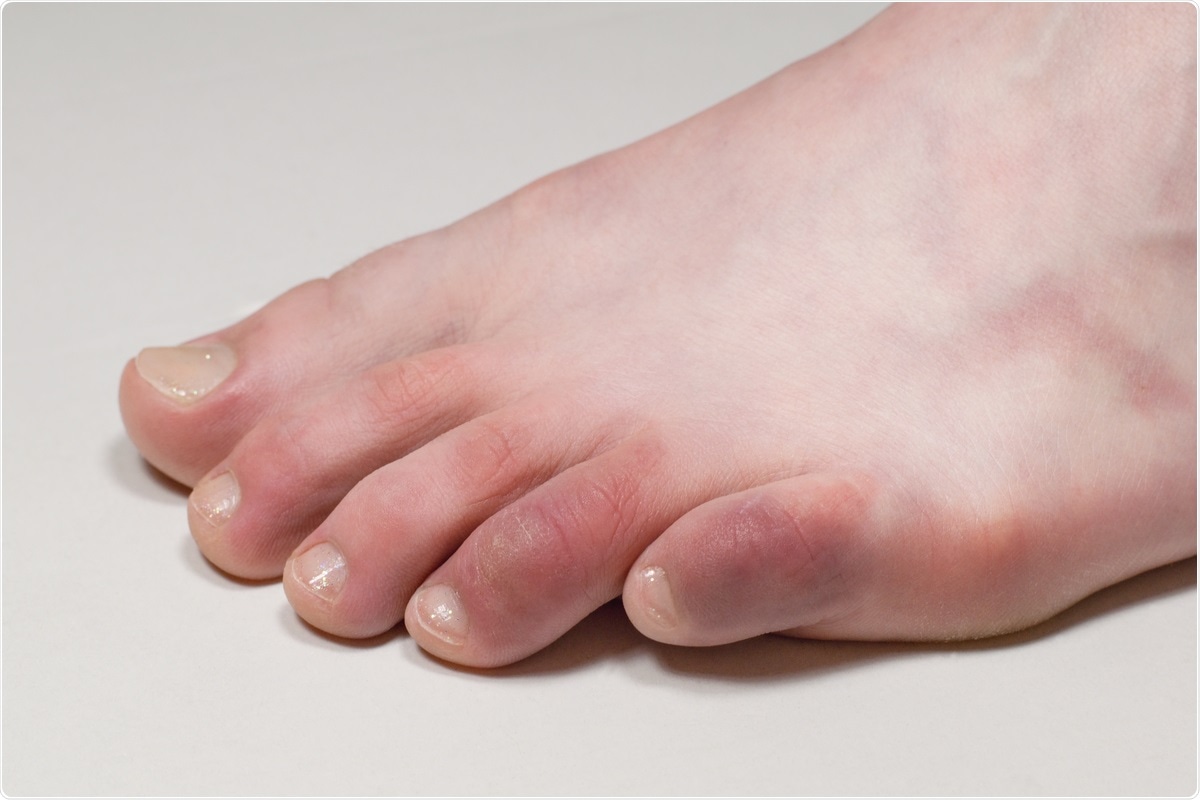Along with the rise of coronavirus disease 2019 (COVID-19) cases, which are caused by infection with the severe acute respiratory syndrome coronavirus 2 (SARS-CoV-2), there have also been increased reports chilblains diagnoses, which has led to speculation on the relationship between chilblains and SARS-CoV-2 infection.
A recent Proceedings of the National Academy of Science study provides a better understanding of whether SARS-CoV-2 infection is linked with the occurrence of chilblains.

Study: Lack of association between pandemic chilblains andSARS-CoV-2 infection. Image Credit: Tunatura / Shutterstock.com
Chilblains and COVID-19
Chilblains is an acral inflammatory rash that is generally found on the toes and fingers of adults in colder and wetter conditions. Although chilblains is not associated with any respiratory viruses, a surge in chilblains in regions with a high rate of COVID-19 has been observed.
In fact, an increased percentage of PC cases, such as severe recalcitrant type of chilblain eruption, in individuals infected with SARS-CoV-2, even in warmer conditions, has been reported. As a result, some researchers have linked the two occurrences and have raised some controversy about using terms like “COVID toe,” which has been referred to as pandemic chilblains (PC) in this study.
Several observational reports have provided circumstantial evidence emphasizing the link between PC and SARS-CoV-2 infection; however, very limited immunological and polymerase chain reaction (PCR) data are available to support this assumption. Owing to these reports, many idiopathic chilblains have been treated differently, as they were presumed to have occurred due to SARS-CoV-2 infection.
In the current study, researchers hypothesize that in-depth immunological profiling of both antibody and T-cell responses of convalescent patients may provide better insights to understand the relationship between these two conditions.
About the study
In the current study, researchers utilized a small cohort of twenty-three PC patients that did not have any history of PC or SARS-CoV-2 infection during the first wave of the pandemic in Connecticut. Taken together, the study cohort included only two patients with chilblain infections and a history of prior SARS-CoV-2 infection. None of the household members of these infected individuals reported infection.
The scientists determined antibody responses using end-point titration enzyme-linked immunosorbent assay (ELISA) and serum epitope repertoire analysis. T-cell responses to SARS-CoV-2 were determined by T-cell receptor sequencing and in vitro SARS-CoV-2 antigen-specific peptide stimulation assays.
Study findings
The study cohort included patients who were diagnosed and treated for “COVID toes” during the pandemic. The researchers did not find any evidence that revealed the occurrence of chilblains associated with SARS-CoV-2 infection.
Thus, the scientists provided an alternative explanation of the connection between PC and SARS-CoV-2 infection. Moreover, an increase in the incidence of chilblains might be due to differential behavior of individuals during the pandemic; for example, not wearing socks/shoes at home during quarantine.
The researchers hypothesized that PC patients may develop chilblains as a result of their potent type I interferon (IFN) response. A previous study also reported the presence of robust type I IFN responses with ex vivo stimulation of whole blood with α-CD3 and TLR7/8 agonists in PC patients. The scientists believe that PC patients exhibit higher type I IFN responses as compared to an age-matched healthy control group.
Another group of researchers stated that PC is a late finding that is linked to COVID-19. Previous studies have indicated younger and healthier patients are primarily infected by PC.
When the same group contracted mild SARS-CoV-2 infection, viral load and type I IFN responses peaked in the first week and declined thereafter. However, there is a lack of evidence indicating the specific time of PC development to correlate it with the time of systemic increase in type I IFN and IFN-stimulated genes.
Notably, some interferonopathy patients exhibit characteristic acral chilblain-like eruptions. Thus, systemic elevation in type I IFNs is not a signature condition associated with PC.
The analysis of stained pre-pandemic tissue samples revealed that antibodies may stain tissues non-specifically. Similarly, although electron microscopy has been used to support SARS-CoV-2 in PC biopsies, high interobserver variability associated with this technique raised questions about its authenticity.
Limitations
One key limitation of the current study is that it is a single-center small cohort. The authors expressed their difficulty in procuring other PC tissue samples that previously stained positive for SARS-CoV-2 antigens. Although the current study revealed that there is no association between PC and SARS-CoV-2 infection, more research is required to understand the connection that may exist between these two conditions.x